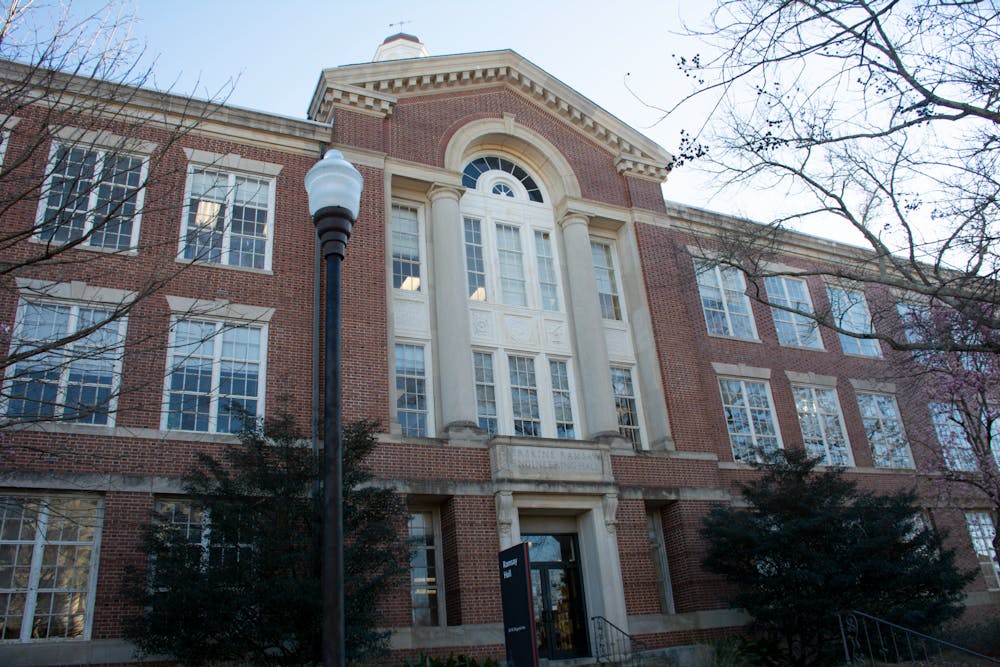To find a fire alarm in Ramsay Hall, you have to go to the building’s basement — but some students are concerned that’s not enough.
“Anytime you’re in a place with classrooms, you’d expect for there to be some type of alarm,” said Chase Gunter, senior in civil engineering who has classes in Ramsay Hall. “We definitely want to know about it.”
The University said the fire alarm system will likely be upgraded in the summer, but currently, Ramsay Hall’s emergency plan outlines what to do in case of fire:
“Manual fire alarms system is located only in [the] basement,” the plan states in red, all-caps type. “Each elevator lobby has a smoke detection system that will activate the fire alarm system in the basement. Occupants of the building should verbally and loudly announce any activation of the fire alarm system as they exit the building.”
Some faculty and staff who work in the building first became concerned when they received the following email from Emmanuel Winful, the project safety manager for the College of Engineering:
“As you may know, Ramsay Building is about 95% without a fire alarm system and heat/smoke detectors. The only fire alarm system is in the basement of the building, and smoke detectors are in the elevators. This system is not loud enough to alert occupants in the rest of the building.”
In the email, Winful goes on to state that a training session would soon take place so that occupants could get familiarized with the building plans and know “what can be done in an event of an emergency.”

Numerous students, faculty and staff in the building expressed shock, concern or confusion about the building’s lack of fire alarms and sprinklers.
While experts in building safety and architecture said the building is compliant and thus safe already for all occupants. They also said a fire alarm system will likely be put into the building this summer.
Winful said the College of Engineering sent a project initiation form — which requested a fire-alarm system be studied — to Facilities Management in November.
Mark Aderholt, the University engineer, said “the chances of the project not going forward are pretty slim” and that he expects a fire-alarm system to be put into the building this summer.
“[Fire alarms are] certainly not required to be put in there,” Aderholt said. “But it certainly adds peace of mind. It’s a ‘Wouldn’t it be safer if?’ scenario.”
Ramsay Hall is compliant with the 2015 international fire code.
The University’s buildings are instead overseen by the Alabama Department of Finance and Real Property Management; specifically, under the department’s division of construction management.
Since the building was built in the fall of 1925, the code requirements are different from those for newer buildings, which must comply with updated codes. Ramsay Hall’s almost-century-old status warrants the building’s less-stringent compliances.
The code states that a “business occupancy” building, such as Ramsay Hall, does not require sprinklers and that existing business occupancy buildings are not required to install fire alarms.
Fire alarms were added to the basement of Ramsay Hall when the building was renovated in the summer of 2004. The renovation meant the University was required to input one fire alarm, bringing that specific part of the building up to code; because the rest of the building wasn’t renovated, no fire alarms were required to be added — and they still haven’t been.
The only way the University would be forced — by code requirements — to install fire alarms and sprinklers would be if a renovation that costs 50% of the building’s worth is completed, according to the international fire code.

Simon Yendle, the university architect for Auburn, said a full-scale renovation of Ramsay Hall is due, but that it’s difficult to know when exactly that will happen.
Yendle said that Ramsay Hall is “absolutely not” an unsafe building, but he emphasized that improvements could always be made.
“If we thought it was a safety risk, then we would’ve initiated something sooner,” Yendle said. “It’s not necessarily unsafe.”
The walls of the interior of the building are clay blocks, which improve fire safety, according to Yendle. And Winful said the walls are one-hour fire-rated, which prevents the spread of fires for one hour.
Ramsay Hall is compliant with codes, and according to experts, safe as is. But for some people who spend vast amounts of their school and workday in the building, not going above and beyond the code is worrisome — especially given the building’s age.
Trista Head, senior in civil engineering, said she’s constantly in Ramsay Hall for her classes. Knowing there are no fire alarms makes her doubt her safety in the building, she said.
“I feel like in an emergency if there’s no fire alarm … it’s more of a panic to get out,” Head said.
She said it would be safer to have more fire alarms.
“I feel like most students probably don’t know that,” Head said. “But ... we should.”
Sheryl Seals, an associate professor in computer science and software engineering who’s taught classes in Ramsay Hall before, said she hopes “resources will be allocated to have adequate protection” for students frequenting the building.
Nelson Leary is a graduate student in civil engineering and has an office in Ramsay Hall. He said that while he’s not as concerned about a potential fire as some other occupants in the building, he still thinks it wouldn’t hurt for the University to renovate.

“Undergrad and [graduate] students come here to teach, and there’s a whole bunch of offices,” Leary said. “[Ramsay Hall] needs to be a safe environment for both learning and conducting research and typing papers.”
Hannah Harry said the building currently poses a potential safety risk if there are only a couple of people in the building: for example, if a student has swipe access and is in Ramsay Hall after 5 p.m.
“That’s really unsafe if there are only one or two people in there because there’s no way to communicate,” Harry said.
Many workers in Ramsay Hall said they couldn’t provide their thoughts on the lack of fire alarms because they were asked to refer questions to Facilities Management and Winful.
Winful sent an email in November 2019 that asked about holding a training session and detailed what the procedure would be in the case of a fire: Call 911, and on the way out, loudly let everyone know there is a fire.
He also discussed a group notification system through Microsoft Teams that allows occupants to notify each other in cases of emergencies. That email was him being proactive, he said. No one was sending him questions about fire safety before then. He said it was important to train people and get them up to speed with emergency plans.
“Some [occupants] have been in the building for 30-plus years, and they did not know [about the lack of fire alarms] until that training,” Winful said. “In a building that does not have those kind of alarm systems, those suppression systems, what is the best practice? And the best practice is to train people so that they can actually know how to react in the event of a fire.”

The training involved going over the floor plans, exit locations and how one must leave Ramsay Hall, according to Winful.
Winful said it’s important when discussing safety that compliance and the occupants’ comfort is taken into account.
Aderholt said Facilities Management takes “safety concerns very seriously” and that they look forward to bringing peace of mind through the installation of fire alarms soon.
“We routinely go above and beyond the code with a lot of different things, not even just fire and life safety,” Aderholt said. “The code really is the minimum.”
This article was prepared by The Plainsman's Investigations Team: reporters Natalie Beckerink, Trice Brown, Elizabeth Hurley, Loren Kimmel, Evan Mealins, Eduardo Medina, Tim Nail and Jack West. It was written by Medina.
Do you like this story? The Plainsman doesn't accept money from tuition or student fees, and we don't charge a subscription fee. But you can donate to support The Plainsman.

Eduardo Medina, senior in journalism, is the editor-in-chief of The Auburn Plainsman.





